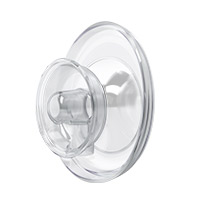Why does my baby prefer sleeping while being held?
Firstly, we’d like to assure you that, despite what you may believe, your baby isn’t plotting to steal all of your free time — just most of it, but hey, that’s all part of the job.
No, the reason they crave being held is rooted in biology. For nine months, your baby was suspended in space — a universe meant just for them — with every biological desire automatically and instantly provided for. They weren’t just near you, they were a part of you, living in an environment crafted through millions of years of evolution to provide the ultimate comfort, soundtracked by the constant, soft rhythm of your heartbeat.
So, when they’re born, it’s only natural that they’ll crave the next closest thing to this — snuggling up in your arms, safe, cozy, and next to your heart. As your baby’s attachment to you grows during these early months, they’ll often crave the comfort of your smell, your touch, and even your voice.
But it’s not just comfort causing the clinginess — being close to you regulates their breathing, heart rate, and even their body temperature. So, if they’re dozing off happily in your arms but waking up the moment you put them down, it’s not because they’re spoiled or trying to mess you around (even if we’ll concede that babies seem rather devilish even at the best of times). No, it’s just their natural survival instincts kicking in.
What are sleep associations?
Babies are quick learners, especially when it comes to sleep. If they’ve gotten used to falling asleep in your arms, that becomes their go-to comfort zone. This is what’s known as a sleep association, and it’s basically a habit your baby forms around how they fall asleep — a little like how we adults tend to favor a specific spot to lounge around in the living room.
If your tot tends to fall asleep while being held, they’ll naturally come to expect that you’ll be there whenever they wake up — you can see how this might lead to plenty of sleepless nights for you!
So, how do you start shifting these sleep associations to something a bit more manageable — like, say, the bassinet or crib? By creating new, positive habits for your baby that don’t require them to be attached to your bosom.
How to get your baby to sleep without being held
Okay — let’s get to the good stuff: solutions. Below, we’ve put together a few expert-approved tips for helping your little one transition into sleeping without needing to be held.
Create a calming sleep environment
Remember earlier when we mentioned how your baby’s clinginess can be traced back to their earliest experiences of comfort in the womb? Well, one of the best ways to encourage them to sleep in their crib is by recreating this environment as closely as possible. You want it to be warm, dark, and uber-cozy. Here’s how to do it:
Temperature: Aim for a room temperature between 68-72°F (20-22°C). Babies can’t regulate their body temperature as well as adults, so keeping them comfortable is the key to a minimally-disturbed night.
Lighting: Use blackout curtains to block out any light that could interfere with their sleep. The darker, the better.
Bedding: Make sure their mattress is firm (no soft pillows or blankets — these can be dangerous!) and use a fitted sheet. If your baby likes swaddling, a snug swaddle can help mimic the feeling of being held — just be sure to follow safe swaddling guidelines.
Make the transition gradual
Going from snoozing in your arms to sleeping independently can be a big step for your little one, so ease the process by aiming for a slow yet steady transition.
Start by holding them until they’re drowsy but not completely asleep. Then, gently place them in their bassinet or crib. This teaches them to associate the crib with falling asleep, rather than just waking up in it and wondering “where on earth am I?”
After laying them down, stay close by and offer soothing words or gentle touches. You can gradually decrease your involvement over the course of a few weeks — this is known as the “sit and soothe” technique.
Try the 5 S’s
Developed by world-famous pediatrician Dr. Harvey Karp, the “5 S’s” are a great way to help calm your baby. Not familiar? We’ve got you covered.
Swaddle: Wrap your baby snugly in a swaddle to mimic the cozy confines of the womb.
Side or Stomach Position: (While holding — never for sleeping in the crib!) Hold them on their side or stomach for a moment to help soothe them. Once they’re asleep, always place them on their back.
Shush: Make a gentle shushing sound to mimic the white noise of the womb. You can also use a white noise machine for this.
Swing: Rocking or swinging can mimic the motion they felt while you were pregnant. You can do this in your arms or with a swing or vibrating seat.
Suck: Allowing your baby to suck on a pacifier or their thumb can be very comforting.
Use white noise
White noise can be a little divisive — something we’ve covered in our dedicated white noise guide — but many parents find that it helps their tot’s travels to slumberland, so if you’re losing hope, it’s certainly worth a shot (just remember to keep volume levels below 50dB, and make sure the device is at least 7 feet away from your baby at all times!)
White noise machines create a soothing “noise blanket”, and can help to block out any other disturbing sounds that might otherwise wake your baby up. If you’d rather not splash out on a dedicated device though, you could always try one of the following alternatives:
A fan or air purifier: They provide a gentle, consistent hum that can soothe your little one.
Apps or playlists: There are plenty of apps and playlists with soft, relaxing sounds specifically designed for sleep.
Learn your baby’s wake windows
Every baby has a specific amount of time they can be awake before they get overtired (which can make it harder for them to fall asleep). Here’s how to figure it out:
Keep an eye on your baby’s cues: Watch for signs of tiredness like yawning, rubbing their eyes, or fussiness.
Track their wake times: Most newborns can handle about 45-60 minutes of awake time, while older babies might be able to stay awake for longer — up to 2-3 hours as they grow. Adjusting bedtime accordingly can help them drift off more easily, but each baby is different so stay curious and notice how long your baby is happily awake for.
Check for signs of acid reflux
If your baby seems particularly fussy after eating or has trouble sleeping flat, they may be experiencing acid reflux. Here are a few ways to help:
Keep them upright after feedings: Hold your baby in an upright position for about 20-30 minutes after feeding to help prevent reflux.
Consider your feeding method: If you’re bottle-feeding, for example, make sure the nipple size is appropriate to prevent them from gulping air. It’s also important to assess their latch and positioning on the bottle or breast.
Try baby massage
The idea’s pretty simple — just introduce a short 10-15 minutes of gentle, soothing massage before bedtime. Repeat this, and over time, your tot should start to associate the relaxing strokes of your massage with sleep. Start from their toes and legs, work your way up, and then — if they allow you to — gently flip ’em onto their tummy and work on their back.
Make a routine — and stick to it!
Routine — it’s something we tend to go on about here at Elvie, and for good reason. Babies thrive on a consistent routine, and by establishing a set time for slumber, you’ll stand a much better chance at transferring your little one from in-arm snoozes to independent bedtime.
To maximize your chance of success, keep things simple. Choose one or two calming activities that you can link to bedtime — a warm bath, storytime, or as mentioned above, a soothing massage. Aim to put your tot in their crib or bassinet within a set 20-30 minute window each night and eventually, they’ll learn to anticipate being put down at around the same time, making the transition much less stressful for both of you.
Things to watch out for
Unfortunately, every parent has to struggle through a tricky transitional bedtime period — it’s all part and parcel of the childrearing experience. However, sometimes these trying times can have more serious underlying causes.
If you notice any of the symptoms below, or if your parental instincts are telling you something just feels off, don’t hesitate to reach out to your pediatrician. Even if it turns out to be nothing serious, it’s always better to have peace of mind.
Baby screams when put down
If your baby is crying or screaming excessively or seems especially uncomfortable once bedtime rolls around, it could be more than just typical twilight fussiness. Prolonged, inconsolable crying (often referred to as colic-like behavior) could indicate gastrointestinal issues, food intolerance, or even something like acid reflux.
What to watch for:
Arching their back while crying
Pulling their legs toward their belly
Fussiness during or after feeding
Noisy breathing
As obvious as it may seem, breathing issues should never be taken lightly. Whether your baby’s snoring loudly or gasping for breath, if you notice any breathing irregularities at all, consult your pediatrician immediately.
What to watch for:
Loud, raspy breathing
Pauses in breathing during sleep
Labored breathing or flaring nostrils
Frequent night waking
Yes, babies tend to wake up a lot at night, and it’s typical for you tot to rouse every 2-3 hours during the newborn period, but if they’re waking up constantly and seem particularly averse to drifting back to sleep, there may be an underlying medical reason.
What to watch for:
Waking up every hour or more frequently, despite consistent soothing efforts
Difficulty falling back asleep, even after being fed or comforted
Skin rashes or allergic reactions
If your baby seems particularly displeased during bedtime, check them for rashes. Allergies or eczema can play havoc with your tot’s sleep schedule, and if they’re waking up scratching or seem extra fidgety during the day, this could be the culprit.
What to watch for:
Red, inflamed skin or patches of eczema
Scratching or rubbing their face during the night
Unexplained rashes or hives that seem to worsen during sleep
At Elvie, we understand that getting your baby to sleep soundly and independently can feel like an uphill battle, but trust us — a little perseverance goes a long way, so stay strong! For more help with your baby’s sleep habits, check out our comprehensive guide to navigating sleep regressions, or head to our index to view our entire archive of expert-approved parenting posts.
Reviewed by Rosey Davidson, Sleep Consultant, founder & CEO, in November 2024.











 10 minute read
10 minute read